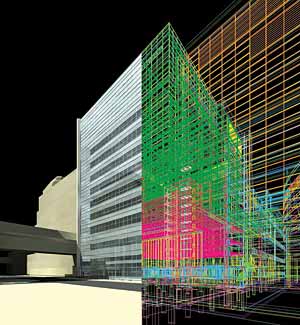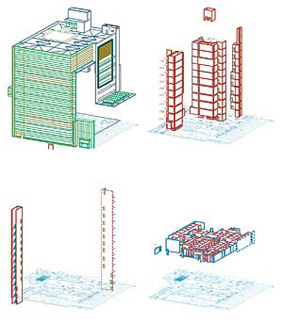Transformative Tools Start to Take Hold
Never too early
Many sources say that a true building information model (or one that exploits the BIM process to its fullest potential) is based on an information resource shared among all participants and stakeholders throughout the life of a project, from the earliest phases of design through occupancy. However, such comprehensive deployment is still not the norm. Instances of implementation from the start to the end of a project are still rare, says Mieszko Niedzwiecki, AIA, vice president and director of design at Leo A Daly. One of the firm's current BIM projects is the renovation of a library and design of two new buildings for Georgia State University in downtown Atlanta. Niedzwiecki and his team used BIM even before schematic design to explore programming issues, phasing, and the urban design implications of the proposed project.
Although BIM users constantly refer to "the model," in actual practice, a multidisciplinary project team is rarely, if ever, served by a single, seamless database. Instead, teams rely on a series of models usually organized by discipline, and are often dependent on different software platforms. The models are generally updated and coordinated at regular intervals, often via a project extranet.
|
||||
Even within their own offices, architects employ numerous software tools from a variety of vendors, exploiting the strengths of each. Such is the case with New York City−based SHoP Architects. The firm typically uses AutoDesk Revit to manage a project's database but picks and chooses from other programs for the one best suited for the particular design problem at hand, explains principal William Sharples.
For a 26,000-square-foot, 9-unit condominium building under construction in downtown Manhattan, SHoP used four programs, each from a separate software company, to design the building's faceted panels of brick and precast concrete. The architects quickly sketched the cladding's complex surfaces with the 3D modeling and visualization tool Rhino. But in order to understand the relationship of one brick to another and determine the configuration and placement of the eight different panel types, they used Gehry Technologies' Digital Project and Bentley Systems' parametric tool, Generative Components (GC). These two programs were employed in tandem to take into account factors such as material properties, transportation limitations, and the fabricator's manufacturing constraints. This cladding data was periodically imported into, and coordinated with, the project's Revit master model and regularly shared with the fabricator, says Federico Negro, SHoP project manager.











